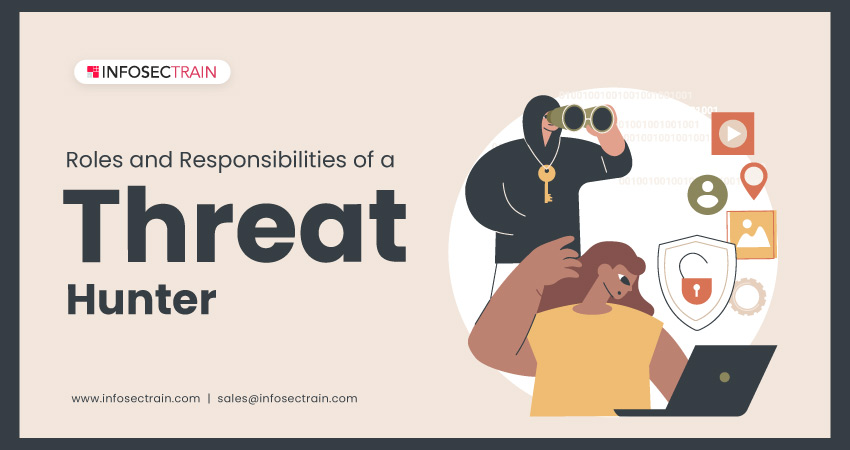Roles and Responsibilities of a Threat Hunter
Cybercrimes are increasing rigorously, along with advanced approaches and tricks used to identify vulnerabilities in the system. Even conducting the necessary testing, there can be a chance of undetected vulnerability that remains in the system for a long time. Such vulnerabilities create an attack surface that further allows attackers to exploit.

Table of Contents
What is Threat Hunting?
Who is a Threat Hunter?
Why are Threat Hunters important?
Responsibilities of a Threat Hunter
Job Roles of Threat Hunter
To identify such undetected vulnerabilities, threat hunters become the line of defense against cyber incidents, attacks, and Advanced Persistent Threats (APT). They play a crucial role in the organization in identifying such vulnerabilities in the system.
What is Threat Hunting?
Threat Hunting is a proactive approach used to identify unknown, undetected, and non-remediated cyber threats in the organization’s network. These threats can compromise the automated defense systems resulting in a cyber threat. Cyber threats are identified using threat hunting methodologies and techniques such as automated threat detection.
Who is a Threat Hunter?
The Threat Hunter is a skilled information security professional responsible for identifying, isolating, and resolving advanced threats in the organization’s network. They actively search for vulnerabilities and mitigate cybersecurity risks that affect the organization. Threat Hunter plays a prominent role in organizations combating threats using traditions and advanced detection techniques.
Why are Threat Hunters important?
Cyber attackers are becoming skilled and advanced in exploiting the organization’s network. Threat hunters are essential, and they become a front-line defense system for the organization in predicting, isolating, and identifying vulnerabilities in the network. They use threat detection technologies such as Endpoint Detection and Response, Security Information and Event Management (SIEM), and other security analytics tools. Effective threat hunting helps to reduce the time and cost of the damage made by the attackers.
Responsibilities of a Threat Hunter
A Threat Hunter is a skilled hunter responsible for identifying vulnerabilities in the organization’s security system. The following are the responsibilities of a Threat Hunter:
- Supervise the endpoints of the system, such as IP addresses, devices, phones, and desktops
- Assist IT teams in using the appropriate methods, tools, and techniques to detect and mitigate cyber threats
- Design and implement networking best practices with a clear understanding of how data processes in the network
- Investigate the network systems or endpoints to identify threat patterns or indicate compromise and analyze the threat
- Search for security gaps by performing risk assessment, penetration testing, and identifying internal risks
- Report the identified threats to the Security officer or Security Operations Center
- Coordinate with the management team to resolve the cyber threats and patch the security system to prevent the same attack from recurring
- Advance the skills with the latest technologies and tricks in cybersecurity
Security professionals evaluate cyber threats using the 80/20 rule, in which 80% of the cyber threats are simple and can be mitigated by the best security practices. Whereas the other 20% are complex cyber threats, and half of these complex threats can be addressed and mitigated with blocking and tackling methods. The other half of the complex threats remain in the top 10% of sophisticated cyber attacks, and traditional methods cannot identify such complex threats.
In such instances, threat hunters aim to identify and resolve highly advanced threats with advanced tools and techniques. They are responsible for identifying threats from insiders and outsiders, including organized attack groups. Once the Threat Hunters identify the threat, they tend to gather as much data as possible, including the objectives, behavior, and strategies of the threat. They prioritize and analyze the data collected to identify security patterns and patch the existing vulnerabilities in the organization’s security posture.
Job Roles of Threat Hunter
Threat Hunting is a demanding career opportunity for beginner and experienced professionals. They are increasing job opportunities with exciting salary packages that one can choose among the following job roles of the Threat Hunter:
- Threat Hunter: The Threat Hunter is responsible for monitoring the security patterns to identify, isolate, and detect the threats before attackers tend to exploit them. The average salary of the Threat Hunter is around $ 83,040 per annum.
- Threat Intelligence Expert: The Threat Intelligence Expert is responsible for analyzing and detecting cyber threats that affect business operations using threat intelligence. They monitor the Indicators of Compromise (IOC) and remediate the cyber threats. The average salary of the Threat Intelligence Expert is around $89,561 per annum.
- SOC Architect: SOC Architect is responsible for planning, creating, and implementing security solutions for the organization. They perform security testing, vulnerability assessment, and risk analysis to identify security gaps in the organization. The average salary of the SOC Architect is around $134,328 per annum.
- Security Analyst: Security Analyst is responsible for protecting the organization’s systems and networks by all possible means from cyber threats. The average salary earned by Security Analysts is around $81,674 per annum.
Become Threat Hunting Professional with InfosecTrain
InfosecTrain is one of the best online training platforms that offers instructor-led certification training programs on Information security and Cybersecurity domains. It provides the Threat Hunting Professional online training course, which helps to understand various threats and threat hunting techniques.







 1800-843-7890 (India)
1800-843-7890 (India)